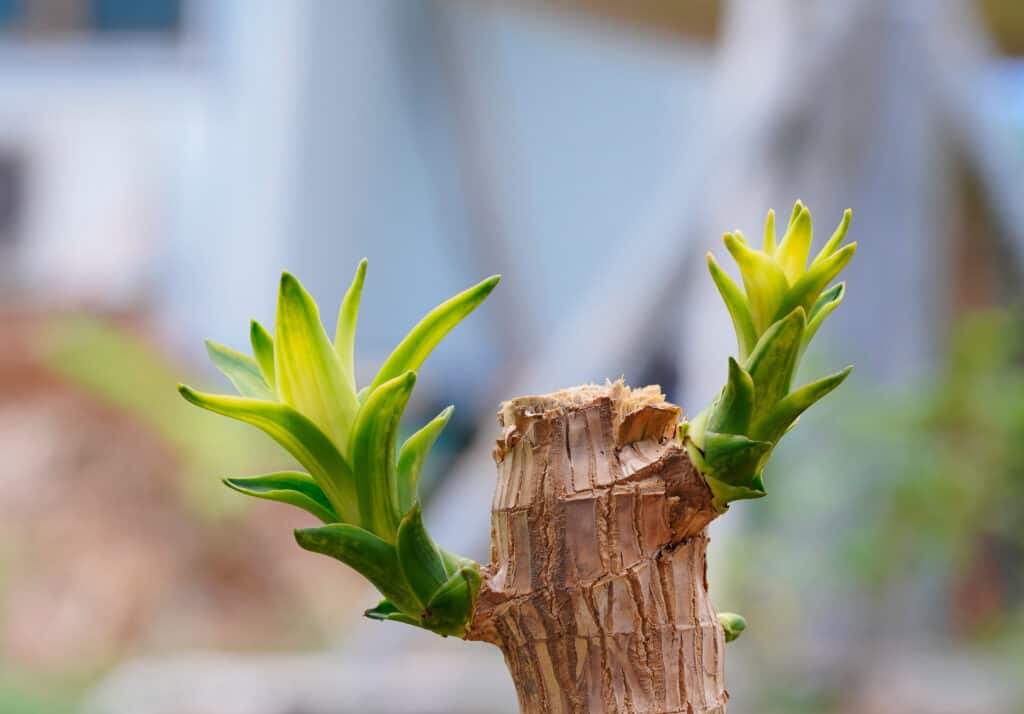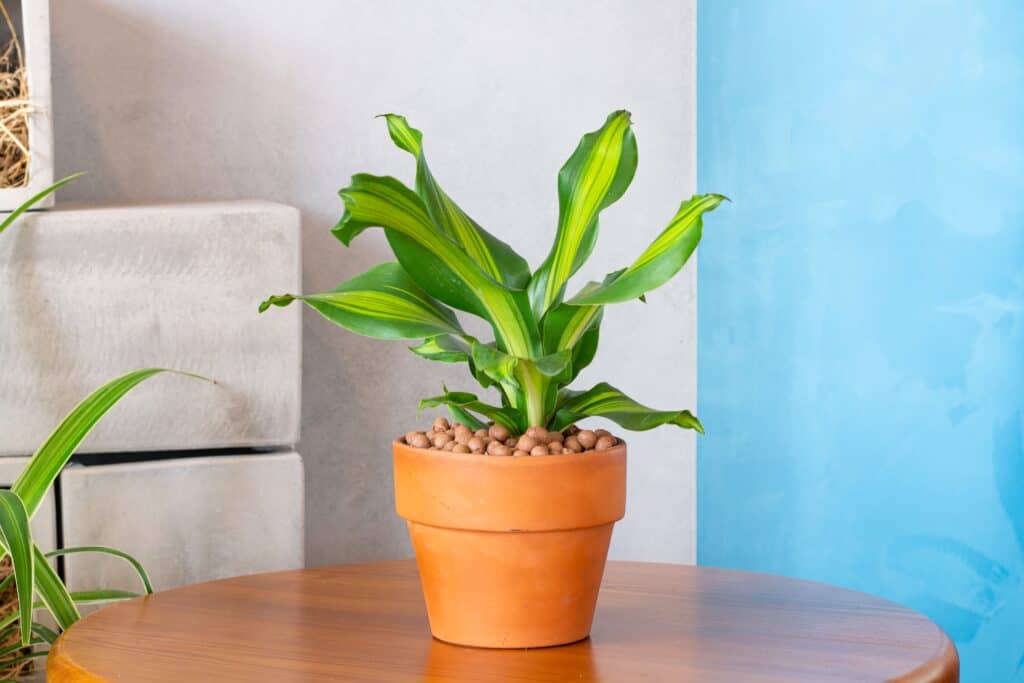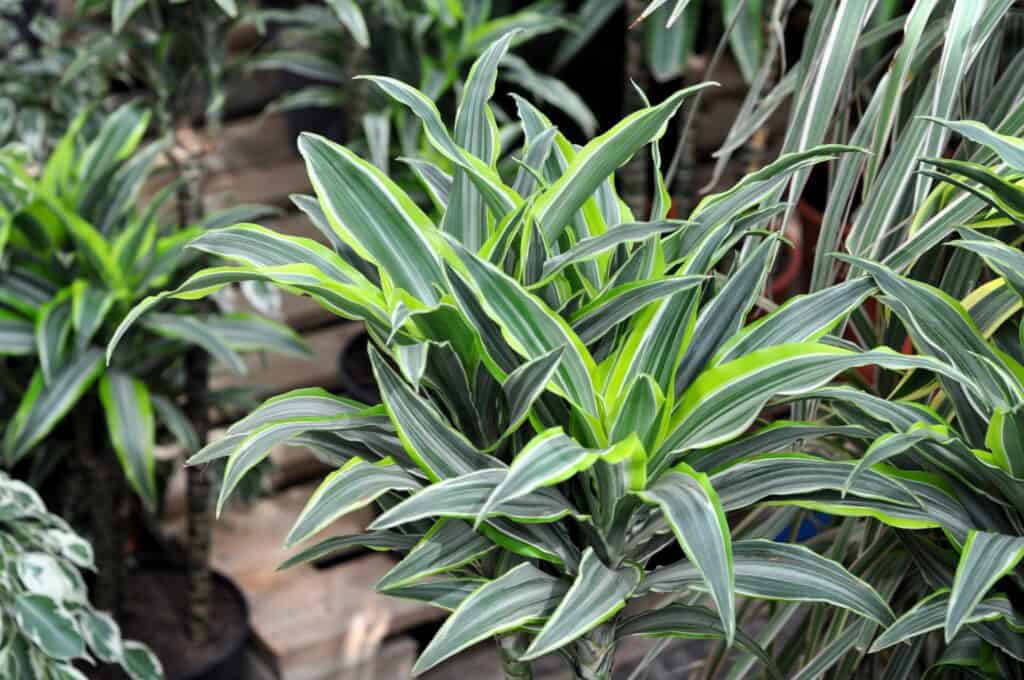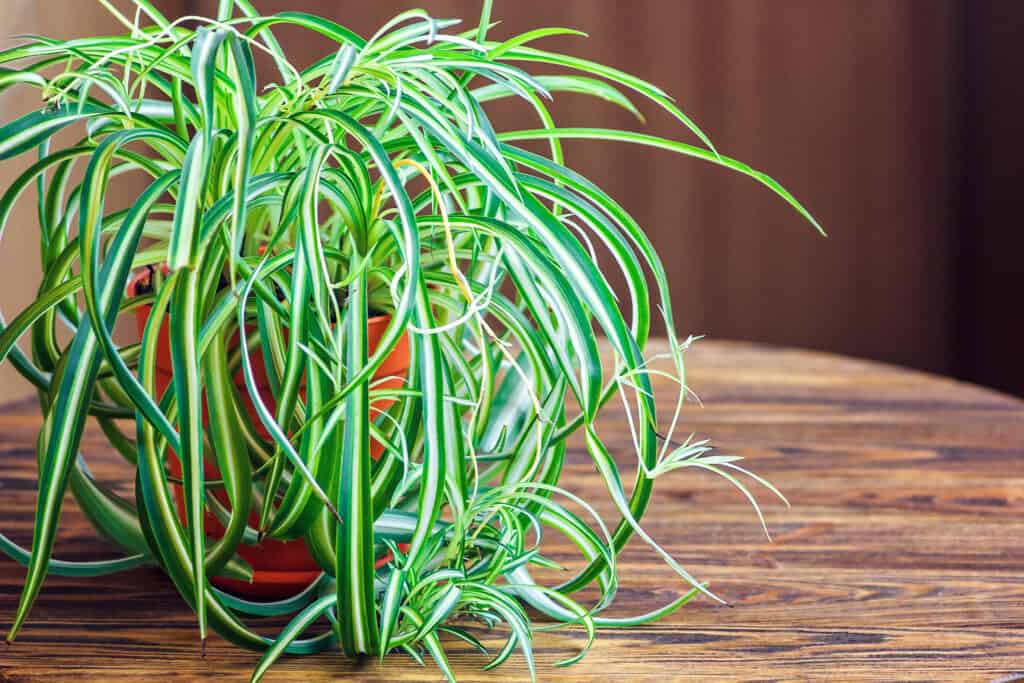If you love nurturing houseplants with lovely striped leaves, you may be familiar with some species of spider plants and dracaena.
We’ll compare the spider plant to dracaena, discussing the plants’ classification, physical characteristics, native ranges, ideal growing conditions, and houseplant care tips.
| Spider Plant | Dracaena | |
|---|---|---|
| Plant Classification | Chlorophytum comosum | Draceana spp. |
| Physical Characteristics | Herbaceous perennial plant that grows 12-24 inches tall with a similar spread. Leaves are long, blade-like, and variegated with white stripes along leaves. Leaf blades can reach 8-18 inches long. Small, white, star-shaped flowers are produced along the end of stems. | Genus of over 120 species of plants that include herbaceous houseplants, woody shrubs, and large trees. |
| Native Range and Ideal Growing Conditions | Native to South Africa. Prefers to grow in filtered sun, but can tolerate shade. Thrives in moist, well-draining soil but can tolerate dry soils and drought. | Most plants are native to Africa, Central Asia, and Northern Australia, with some species are native to Central America. Most species prefer low to moderate drought tolerant. |
| Houseplant Care Tips | Keep plant above 45 degrees Fahrenheit to grow year-round. Reduce watering in the winter and mist leaves in the summer. Water with filtered water for best growth. Does particularly well in indoor hanging baskets. | Houseplant care depends on the species. To keep variegation of some species, make sure to provide enough sunlight. Most houseplant species prefer misting on leaves to reduce excessive dryness in low-humidity indoor environments. |

Dracaena house plants, woody shrubs, and large trees.
©KPhrom/Shutterstock.com
Plant Classification
Spider plant is the common name for the species Chlorophytum comosum, a species of houseplant, while dracaena refers to an entire genus of plants.
The Dracaena genus contains over 120 species of plants that range from herbaceous perennials to woody shrubs and large trees.
Spider Plant vs. Dracaena: Physical Characteristics
Dracaena vary greatly across species in growth habits and physical characteristics. Some species in the genus do have similar characteristics to the spider plant.
The spider plant is an herbaceous, perennial plant that is characterized by its long, often variegated, blade-like leaves. It typically grows 12-15 inches tall with a similar spread. The long leaves can grow 8-18 inches long. The variegated variety has a central white stripe running vertically along the length of its slender leaves. When flowering, the spider plant produces small, white, star-shaped flowers at the end of bare stems that reach up to 24 inches long.

Variegated spider plants have a central white stripe running vertically along the length of their slender leaves.
©Bozhena Melnyk/Shutterstock.com
Draceana most similar to spider plants include Dracaena fragrans and Dracaena deremensis. Both of these plants produce long, blade-like, variegated leaves.
Though Dracaena fragrans has a more upright growing habit than the spider plant, it also has the characteristic lighter stripe running the length of the leaves, which are 18-36 inches long.

has a more upright growing habit than the spider plant.
©Mid Tran Designer/Shutterstock.com
While Dracaena deremensis can grow more like a shrub in outdoor settings, it has blade-like, striped leaves like the spider plant. As a houseplant this dracaena species can also grow in a similar pattern to the spider plant. Depending on where it grows (houseplant vs. outdoors), the long, narrow leaves of Dracaena deremensis can grow between 12-60 inches long!

Depending on where it grows the long, narrow leaves of
Dracaena deremensiscan grow to between 12-60 inches long!
©Oksana Lyskova/Shutterstock.com
Native Growing Ranges and Ideal Growing Conditions
The native growing range of the spider plant is South Africa, while the genus of Dracaena contains species that are native to Africa, Central Asia, Northern Australia, and Central America.
Spider plants prefer to grow in filtered sun in moist, fertile, and well-draining soil. Though they can tolerate full shade and drought, spider plants will not thrive in soggy soil.
As a genus, many species of dracaena thrive in low to moderate humidity, moist, fertile soil, and filtered sunlight. Like the spider plant, most species of dracaena do not tolerate soggy soil. Placing a dracaena in direct sunlight can result in leaf burn, so be mindful when choosing where to position dracaena in your home or office.
Spider Plant vs. Dracaena: Houseplant Care Tips
Both the spider plant and several species of dracaena are popular houseplants.
Spider plants require indoor temperatures of at least 45 degrees Fahrenheit. To help them thrive, make sure the soil stays moist but not soggy. You can mist their leaves in the summer to prevent any leaf tip crisping. In the winter, reduce watering to avoid soggy roots, and always try to water with filtered water. Tap water often contains an excess of minerals that many houseplants don’t handle well. This plant does particularly well growing in hanging baskets where its long leaves can hang gracefully over the sides, away from the soil.

Spider plants require an indoor temperature of at least 45 degrees Fahrenheit.
©Bozhena Melnyk/Shutterstock.com
Similar to the spider plant, many species of dracaena grown as houseplants benefit from misting in the summer and reduced watering in the winter. To keep variegation of leaves, make sure to provide the plants with filtered or direct sunlight. Without enough light, the plants will lose their lovely, colorful striping.
Up Next:
- 7 Best Books About House Plants That Will Stop You From Killing Them
- How Small Are Monstera Houseplants?
- 8 Houseplants That Grow in Water
The photo featured at the top of this post is © ArtCreationsDesignPhoto/Shutterstock.com
Sources
- missouribotanicalgarden.org, Available here: https://www.missouribotanicalgarden.org/PlantFinder/PlantFinderDetails.aspx?taxonid=244287&isprofile=0&
- edis.ifas.ufl.edu, Available here: https://edis.ifas.ufl.edu/publication/FP183
- plants.ces.ncsu.edu, Available here: https://plants.ces.ncsu.edu/plants/dracaena-fragrans/
- hort.extension.wisc.edu, Available here: https://hort.extension.wisc.edu/articles/spider-plant-chlorophytum-comosum/
- a-z-animals, Available here: https://a-z-animals.com/blog/plants-that-are-nearly-impossible-to-kill/
Thank you for reading! Have some feedback for us? Contact the AZ Animals editorial team.






